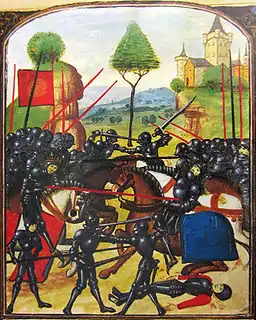
The Battle of Barnet was a decisive engagement in the Wars of the Roses, a dynastic conflict of 15th-century England. The military action, along with the subsequent Battle of Tewkesbury, secured the throne for Edward IV. On 14 April 1471 near Barnet, then a small town north of London, Edward led the House of York in a fight against the House of Lancaster, which backed Henry VI for the throne. Leading the Lancastrian army was Richard Neville, 16th Earl of Warwick, who played a crucial role in the fate of each king. Edward launched his invasion of England, which culminated at the fields north of Barnet. Under cover of darkness, the Yorkists moved close to the Lancastrians, and clashed in a thick fog at dawn. While the main forces struggled in battle, John de Vere, 13th Earl of Oxford, and his Lancastrian troops routed the Yorkists under Lord William Hastings, chasing them up to Barnet. On their return to the battlefield, Oxford's men were erroneously shot at by his allies commanded by John Neville, 1st Marquess of Montagu. The Lancastrians lost the battle as cries of treason spread through their line, disrupting morale and causing many to abandon the fight. While retreating, Warwick was killed by Yorkist soldiers. Historians regard the battle as one of the most important clashes in the Wars of the Roses, since it brought about a decisive turn in the fortunes of the two houses. Edward's victory was followed by fourteen years of Yorkist rule over England. (Full article...)